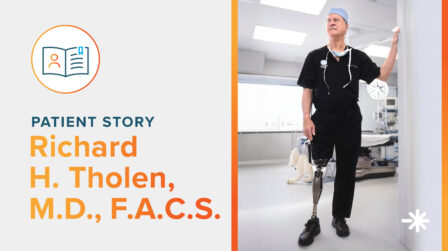Limb Differences Linked with Syndromes
Congenital vascular syndromes that may require orthotic and/or prosthetic care.
Understanding Syndromes Linked to Limb Differences
There are a few relatively rare congenital vascular syndromes that may require orthotic and/or prosthetic care.
Klippel-Trenaunay (-Webber) syndrome (or KTS), Proteus syndrome, and CLOVES syndrome are three examples. In these cases, children are born with limb differences that may require amputation of the involved limb. Each of these conditions has a combination of changes to the circulatory system, skeletal system, and soft tissue. They can result in a difference between leg lengths, skeletal overgrowth (called hypertrophy), venous and lymphatic system problems, and various degrees of soft tissue changes.
Importance of Treatment
Although each of these syndromes has specific characteristics, the main concerns related to orthotics and prosthetics are similar: limb length differences, volume changes, and skin conditions. Without orthotic/prosthetic treatment, patients can suffer from a wide variety of increasing physical complications. This may include pain, decreased mobility, circulatory complications, and scoliosis due to a leg length discrepancy.
Orthotic Interventions:
- Leg length discrepancies – differences in limb length can be addressed by shoe modifications.
- Volume changes – edema and lymphatic drainage complications can be treated with compression garments; custom-made garments are often required.
Prosthetic Interventions:
- Leg length discrepancies
- A prosthesis will make up the difference in length between the two legs. Shoe lifts may no longer be needed.
- Volume changes
- A compression garment or shrinker may be used in conjunction with a prosthesis.
- It is important to maintain a precisely fitting prosthetic socket. Socks can be used to adjust for limb volume fluctuations. An adjustable socket may also be helpful for some patients with volume changes.
- Skin considerations
- There are many options for the materials that are used against the skin in a prosthesis. This includes different types of silicone, gels, or thermoplastics used in the prosthesis to protect the skin. Collaborating with other healthcare professionals, such as dermatologists, may be helpful to develop a skincare treatment plan.
Communication and Support
Routine appointments with healthcare providers, including orthotic and prosthetic clinicians, can help maintain any patient’s quality of life. These appointments provide an opportunity to monitor growth or volume changes, make adjustments to the patient’s prosthesis or orthosis, and talk about future treatment plans.
Your healthcare team can provide resources to offer you options for emotional support as well. One example of support is AMPOWER, which is an online community with peer mentors who can assist in making peer connections, answer questions, and provide emotional support.
Latest Updates
Subscribe to stay up-to-date on our latest posts.


